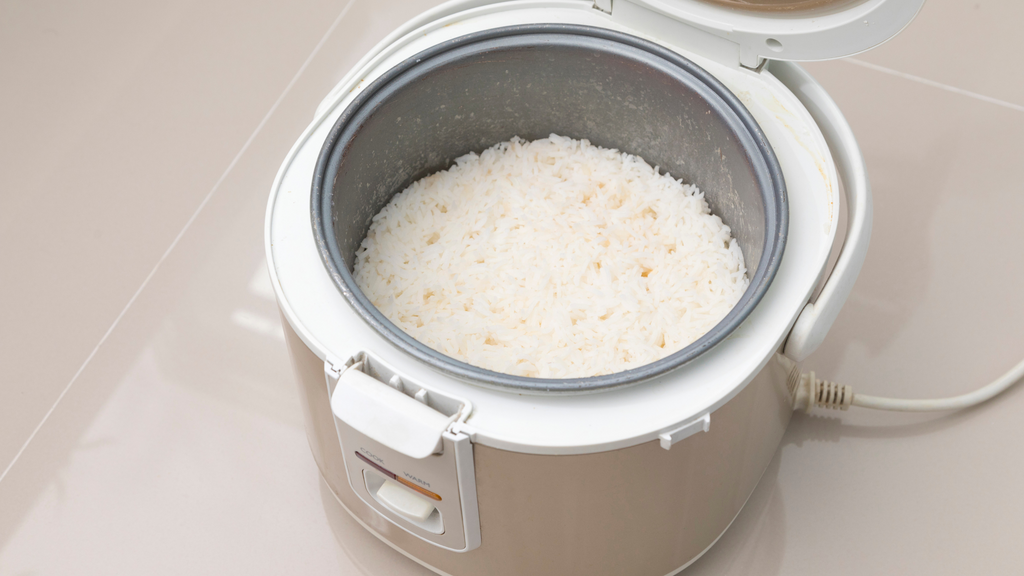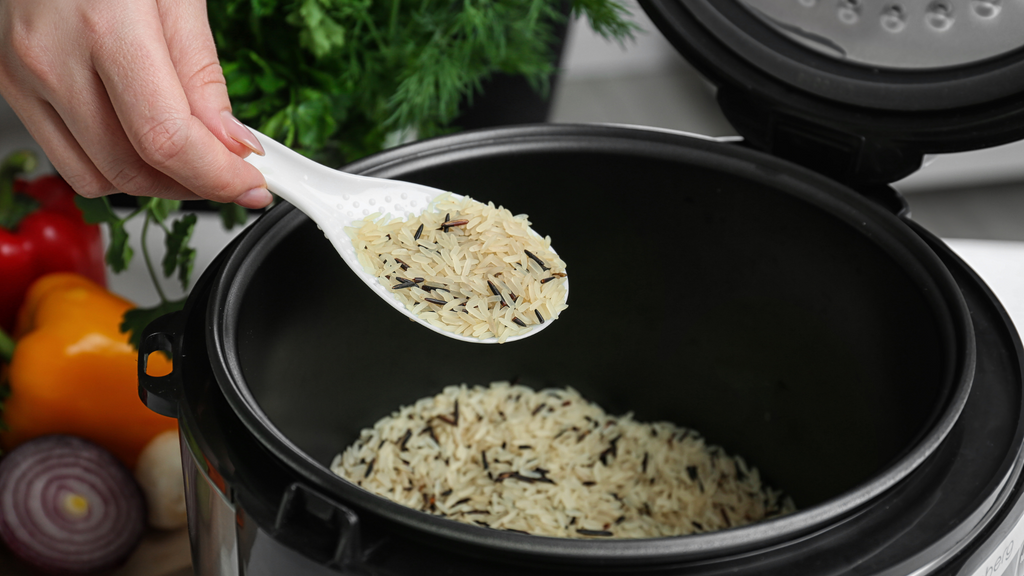Choosing the right rice cooker is essential for a great cooking experience, but why stop there? At Megafurniture, we offer everything you need to create a stylish and functional dining space. Explore our full collection of home and kitchen essentials to complete your setup.
Pair your new rice cooker with a beautiful dining table that suits your space. Need flexibility? Check out our extendable dining tables for versatile solutions. Complement your setup with comfortable dining chairs or a timeless wooden dining table for a classic touch.
What is your rice cooker made of?
While rice cooker stainless steel might be the latest buzzword among cooking enthusiasts, rice cookers come in diverse materials. Each has its own story, from the classic ceramic and non-stick Teflon to the shiny and durable stainless steel.
Let us unpack the world of rice cookers and discover which material might be your kitchen's next best friend.
Rice Cooker Stainless Steel: What is it?

Stainless steel rice cookers are the blend of modern kitchen elegance and functionality. Durable, sleek, and free from controversial non-stick coatings, they offer a healthy alternative for cooking rice. However, like any kitchen gadget, they have advantages and a few minor challenges, balancing the scales between luxury and practicality.
Stainless Steel Rice Cooker Benefits
- Longevity: This material stands the test of time, shrugging off the usual kitchen mishaps like scratches and dings.
- Chemical-Free: Stainless steel stays neutral, ensuring your rice isn't mingling with unintended flavours, especially from acidic or alkaline foods.
- Hassle-Free Cleaning: Its polished surface simplifies cleaning and is a straightforward dishwasher affair for many.
- Pure Cooking: You won't find controversial non-stick coatings here. Many health-conscious individuals prefer this.
- Sleek Looks: The gleaming finish complements a contemporary kitchen decor.
Potential Drawbacks of Stainless Steel Rice Cooker
- The Stick Factor: Absent the non-stick features, one might occasionally find rice clinging more determinedly to the pot.
- Heat Dynamics: While not the best buddy with heat distribution, many premium stainless steel models have copper or aluminium allies to balance this out.
- Heft: Picking up a stainless steel rice cooker might give your muscles more workout than aluminium ones.
- Pricing: Quality comes with a tag, and stainless steel variants might lean towards the pricier side.
Stainless Steel Rice Cooker Useful Maintenance Tips:
|
Ceramic Rice Cookers

A ceramic rice cooker is a rice cooking appliance where the inner cooking pot is made from ceramic instead of stainless steel, aluminium, or other materials. It offers a healthy and even cooking alternative, preserving the natural flavours of the rice. However, their fragility requires careful handling and might come at a slightly higher cost.
Pros of Ceramic Rice Cookers
- Non-Toxic: Ceramic rice cooker is free from chemicals and harmful toxins. They don’t contain metals, making them a safe choice for health-conscious individuals.
- Even Cooking: Ceramic pots heat slowly but distribute that heat more uniformly, often resulting in perfectly cooked rice.
- Flavour Preservation: Ceramic is a neutral material that doesn't interfere with the natural taste of food.
- Non-reactive: Unlike metals, ceramic won't react with acidic or alkaline foods.
-
Easy Cleaning: Ceramic pots are typically easy to clean due to their non-stick nature.
Cons of Ceramic Rice Cookers
- Fragility: Ceramic pots can crack or chip more easily than metal counterparts if dropped or subjected to sudden temperature changes.
- Weight: Ceramic rice cookers can be heavier than other materials.
- Heat Retention: While ceramic retains heat well, it may continue cooking rice even after being turned off, possibly leading to overcooking if not monitored.
- Cost: High-quality ceramic rice cookers can sometimes be pricier than metal versions.
Ceramic Rice Cooker Useful Maintenance Tips:
|
Teflon Rice Cookers

A Teflon rice cooker is a cooking appliance wherein the inner cooking pot is coated with Teflon. Teflon, a brand name, represents a type of Polytetrafluoroethylene (PTFE), a non-stick coating used in various cookware. It offers convenience thanks to its non-stick nature and generally affordable pricing. However, potential health and environmental concerns and durability issues might make some consumers opt for alternative materials.
Pros of Teflon Rice Cookers
- Non-Stick: One of the most significant advantages of Teflon is its non-stick properties. This ensures that rice doesn’t stick to the bottom, making it easier to serve and clean.
- Heat Conductivity: Teflon-coated pots heat up quickly and cook the rice evenly.
- Lightweight: Pots with Teflon coatings are often lighter than ceramic or stainless steel alternatives.
-
Affordable: Teflon-coated rice cookers are usually more budget-friendly than other materials.
Cons of Teflon Rice Cookers
- Durability Concerns: The Teflon coating can wear off over time, especially if scratched by metal utensils or cleaned roughly.
- Health Concerns: If overheated, Teflon coatings can release harmful fumes that are unsafe for inhalation. Also, there are concerns about PTFE breaking down over time and entering the food, especially once the coating wears out. (Tip: Make sure that temperature does not exceed 570’F (300’C)
- Taste and Smell: Some users report a distinct taste or smell, especially when the pot is new, though this usually diminishes over time.
- Environmental Concerns: The production process for PTFE has raised environmental concerns due to the emission of certain greenhouse gases.
Teflon Rice Cooker Maintenance Tips:
|
Rice Cooker Shopping Guide: Stainless Steel, Ceramic, or Teflon?

1. Health Priorities
For health-conscious and prefer materials free from chemicals: Opt for Stainless Steel or Ceramic
If you want convenience but are careful about not overheating or scratching: Opt for Teflon (but ensure you use it as recommended)
2. Cooking Performance
For consistent, even cooking without much monitoring: Opt for Ceramic
For quick cooking and decent heat distribution: Opt for Teflon or Stainless Steel with added conductive layers (like copper or aluminium)
3. Maintenance & Durability
If you're looking for longevity and resistance to dents/scratches: Opt for Stainless Steel
If you want something easy-to-clean and non-stick: Opt for Teflon
If you’re careful and don’t mind being gentle with your cookware: Opt for Ceramic
4. Budget
On a tight budget and want something affordable: Opt for Teflon
Willing to invest in something that might last longer and possibly be healthier: Opt for Stainless Steel or Ceramic
5. Environmental Concerns
If you're environmentally conscious and concerned about production impacts: Opt for Stainless Steel or Ceramic
6. Aesthetic Preferences
For a modern, sleek look: Opt for Stainless Steel
For a classic, timeless appeal: Opt for Ceramic
Key Takeaway:
When choosing a rice cooker, consider your priorities. Whether health, convenience, budget, or durability, a rice cooker out there is just right for you. Always read product reviews and test in-store before making a final decision.
Before finalising your decision, why not explore the diverse range at Megafurniture? With an array of options, styles, and features, you're bound to find the rice cooker that feels like it was made just for you.
Additional Readings:
Best Rice Cookers at Megafurniture (Brands to Watch Out For)
Rice Cooker Recipes for the Busy Singaporean
Interior Design Singapore: Best Firms for Your Next Home Renovation
Your Ultimate Cheat Sheet to Renovation in Singapore: HDB Guidelines, Procedures & Tips
Bonus Treat: Rice Cooker Maintenance and Cleaning Hacks

1. Rinse Before the Cook
Give it a good rinse before setting your rice to boil. This step enhances the texture and cuts down on the starchy mess that's tough to scrub away later.
2. The Magic of Vinegar
Encountered stubborn bits of rice glued to your pot? Try this:
- Fill your cooker pot with warm water.
- Mix in a splash of vinegar.
- Allow it to settle for about 20 minutes, then give it a gentle scrub. Vinegar’s acidic nature helps dissolve that tricky starch.
3. Gentle Cleaning Wins
Use soft cloths or sponges when cleaning, especially when dealing with Ceramic or Teflon surfaces. This approach helps preserve their integrity.
4. Air it Out
After rinsing, place the pot inverted to air-dry, ensuring no moisture traps that can cause mold or odd odours.
5. Attention to the Steam Vent
If your cooker sports a steam release, it can gather starchy deposits over time. Use a petite brush or cloth to keep it unclogged and clean.
6. Under the Lid
For those cookers with removable lids, pop them off occasionally for a separate wash. Sometimes, overlooked residues lurk underneath.
7. No Deep Dives
It's a cardinal rule: never dunk the entire rice cooker (especially the central unit with electronics) in water. Instead, a damp cloth swipe on the outside does the trick.
8. Storage Matters
Stash your cooker in a moisture-free spot once it is clean and dry. This little habit can significantly extend its happy working years.








